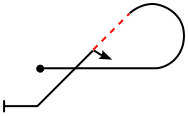Benutzer:Red Rooster/Werkstatt/Kunstflug Manöver
Zur Navigation springen
Zur Suche springen
Aerobatic maneuvers are flight paths putting aircraft in unusual attitudes, in air shows, dog fights or competition aerobatics. Aerobatics can be performed by a single aircraft or in formation with several others. Nearly all aircraft are capable of performing aerobatics maneuvers of some kind, although it may not be legal to do so in certain aircraft.
Liste der Kunstflugfiguren[Bearbeiten | Quelltext bearbeiten]
| Name des Figur | Beschreibung | Aresti-Symbol |
|---|---|---|
| Chandelle | ||
| Chandelle, Wing-over | Es wird eine 180°-Kurve mit gleichbleibender Gasstellung geflogen, in der das größtmögliche Steigen für die jeweilige Eingangsgeschwindigkeit erzielt werden soll. Diese Figur erzeugt nur geringe, positive G-Kräfte und kann mit allen Flugzeugen geflogen werden. | (Keine Wettbewerbsfigur) |
| Cuban Eight | ||
| Kubanische Acht |
|
 |
| Halbe kubanische Acht |
|
 |
| Rückwärts geflogene, halbe kubanische Acht |
|
 |
| Turn; Stall Turn | ||
| Turn; Stall Turn | 1/4 loop (pull or push) to vertical, as momentum/airspeed decreases, rudder is applied and the aircraft rotates around its yaw axis, the nose falls through the horizon and points towards the ground, a momentary pause is made to draw the vertical down line, and 1/4 loop to level flight. This figure is sometimes called a stall turn which is a misnomer because the aircraft never actually stalls. The manoeuvre is performed when the aeroplane decelerates through 20 - 30kts (more or less, depending on the aeroplane flown) of airspeed. The cartwheel portion of the hammerhead is performed with full rudder and full opposite aileron. Gyroscopic forces from the propeller during the rapid rate of yaw will produce a pitching and rolling moment and a degree of forward stick will be required to keep the aeroplane from coming off-line over the top. The yaw is stopped with opposite rudder while the ailerons and elevator remain in position, then once the yaw is stopped and the aeroplane is pointed down vertically, all controls are returned to neutral together. Although they can be flown left or right in any aeroplane with the proper technique, a hammerhead is best flown to the left with a clockwise rotating prop, and to the right with an anticlockwise rotating prop (as in a Yakovlev type), due to propeller torque/gyroscopic effects. |  |
| Immelmann; Roll-off-the-top; Split S | ||
| Immelmann; Immelmann turn; Roll-off-the-top; half loop, half roll | 1/2 looping up followed by half a roll. There should be no pause between the end of the looping section and the start of the roll to erect flight. |  |
| Split S | Essentially an Immelmann in reverse. Half roll (from erect to inverted) followed by positive pitch to give a half loop. Converts altitude to airspeed, and reverses direction. |  |
| Up lines | ||
| Vertical up | Fly the aircraft so that the fuselage is perpendicular to the ground (along the wings' Zero lift axis.) The flight path is not judged, and therefore the aircraft may drift downwind during a vertical maneuver. |  |
| 45° up line | The object is for the airplane flight path to be 45° from horizontal, as viewed by a ground observer. The actual angle flown when viewed by the pilot would differ depending on whether the figure is flown into or with the wind, and wind strength. |  |
| Loop | ||
| Inside loop | A vertical circle entered from straight and erect level flight. A positive pitching movement is used at all points in the loop to draw the circle, so that the aeroplane canopy is pointing inwards. Both the inside and outside loop are sometimes casually referred to as a 'loop the loop'. |  |
| Outside loop | A vertical circle entered from straight and erect level flight, canopy pointing out of the loop. Loop can be above or below the straight and level entry altitude, from erect or inverted attitude. (Draws extreme negative gee) |  |
| English bunt | Half an outside loop starting from upright, straight and erect level flight. (The pilot pushes the stick forward and draws a half circle in the sky from the top down.) |  |
| Spin | ||
| Erect spin; Inverted spin; Flat spin | A family of auto-rotational maneuvers, consisting of normal or "flat" spins, either upright or inverted. Two components must exist to spin an aircraft: 1) critical angle of attack (COA), which means that the aircraft is stalled, and 2) yaw. |  |
| Tailslide | ||
| Tailslide | 1/4 looping up, straight vertical (full power) until the aircraft loses momentum. The aircraft falls backwards, tail first, until the nose drops through the horizon to a vertical down position. 1/4 loop (push or pull) to recovers to level flight. |  |
| Snap Roll; Flick roll; Flick | ||
| Snap Roll; Flick roll; Flick | A family of rapid autorotational or "horizontal spins," not unlike spins. Rotation is induced by a rapid pitch input followed by rapid yaw input, thus stalling one wing further than the other. This imbalance in lift causes the high speed roll. | |
- Dive; extreme nose down attitude (not necessarily vertical), resulting increase in airspeed, and descent rate.
- Lazy eight; 1/4 looping up, wingover (left or right), 1/2 looping down+up, wingover (right or left), 1/4 looping down
- Lomcevak; family of autorotational, tumbling figures. In all varierties, the aircraft appears to tumble out of control. For example, one style involves the aircraft tumbling(simultaneously) nose over tail and wingtip over wingtip in a negative-g, gyroscopic condition. Introduced by Czechs such as Ladislav Bezak, and others.
- Pugachev's Cobra; the nose of the aircraft is pulled up suddenly. The aircraft pitches up to 90° angle of attack. The nose then falls back to the horizontal, and the aircraft accelerates away in the original direction[1]
- Roll; 360° revolution about the longitudinal axis
- Barrel roll; a combination of a loop and a roll. One loop is completed while completing one roll. The flight path during a barrel roll has the shape of a horizontal corkscrew
- The Scissors; flying in a vertical zigzagging pattern.
- Standing eight; inside loop, 1/2 roll (inverts the aircraft), inside loop (towards the ground) 1/2 roll on top of the loop
- Wingover; left or right 180° tight turn (yaw) at the top of a 1/4 looping (up)
- Zoom; extreme nose up attitude (not necessarily vertical), resulting in airspeed loss (not in a jet), and increased rate of climb...
See also[Bearbeiten | Quelltext bearbeiten]
External links[Bearbeiten | Quelltext bearbeiten]
[[Category:Aerobatics]] de:Flugfigur
